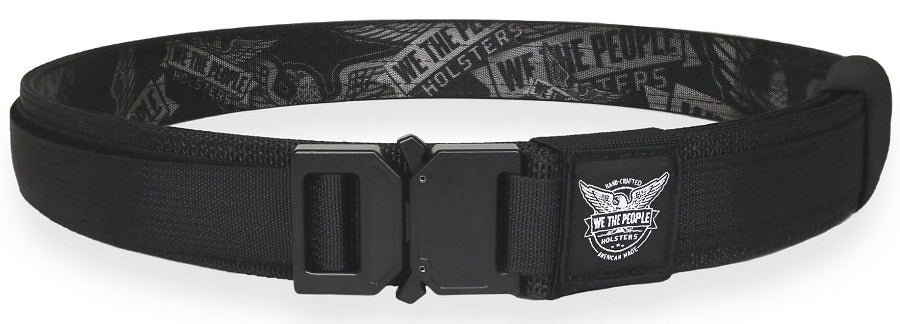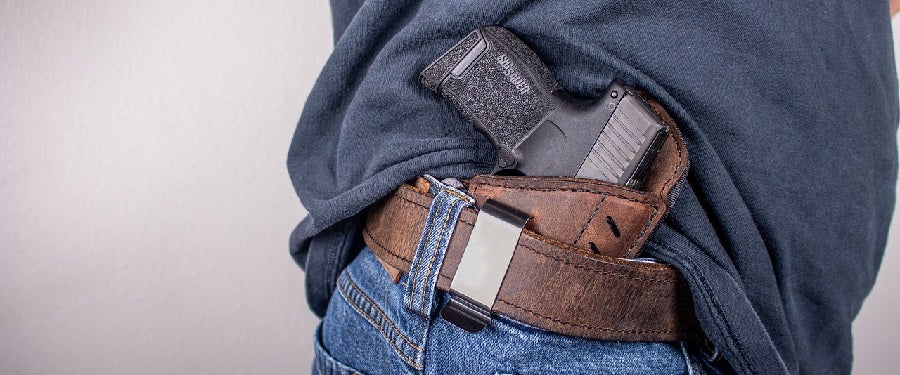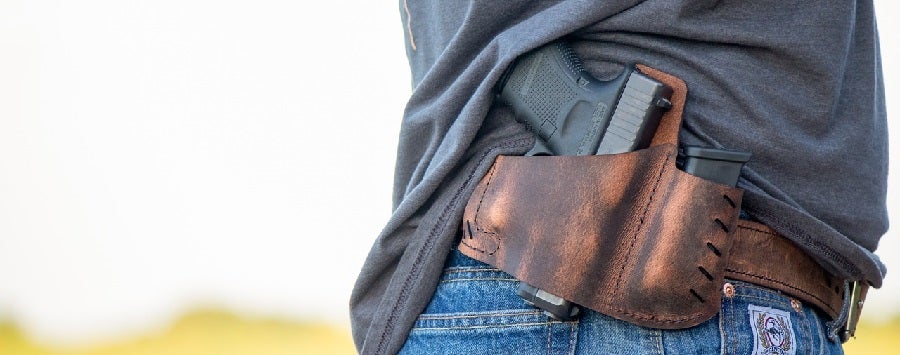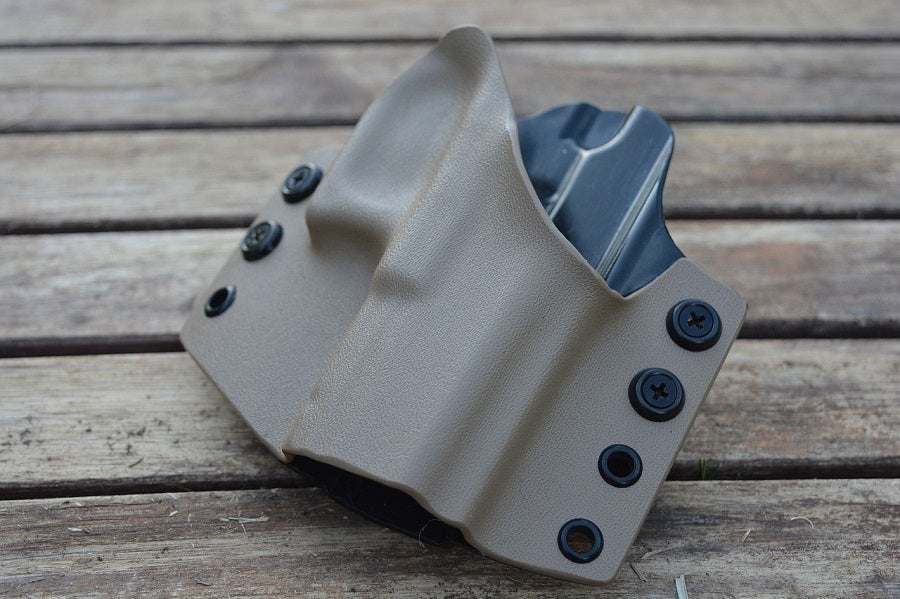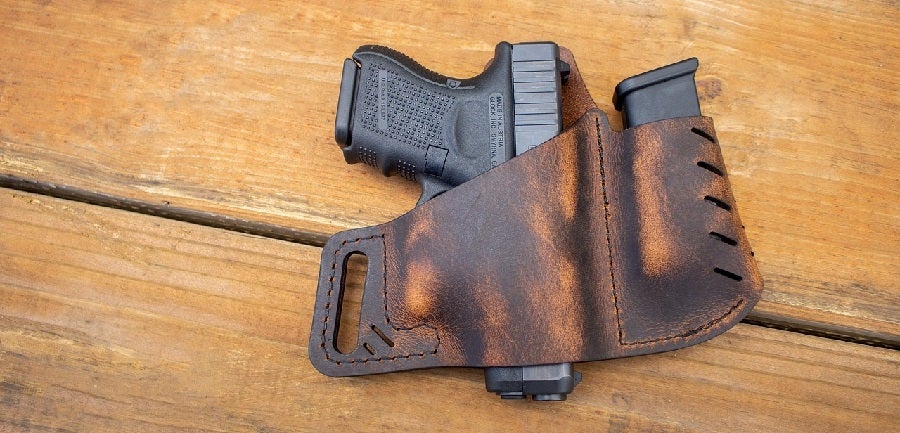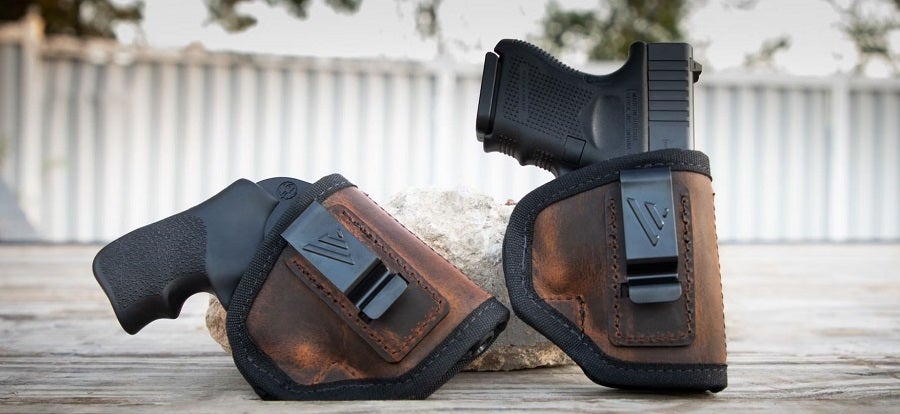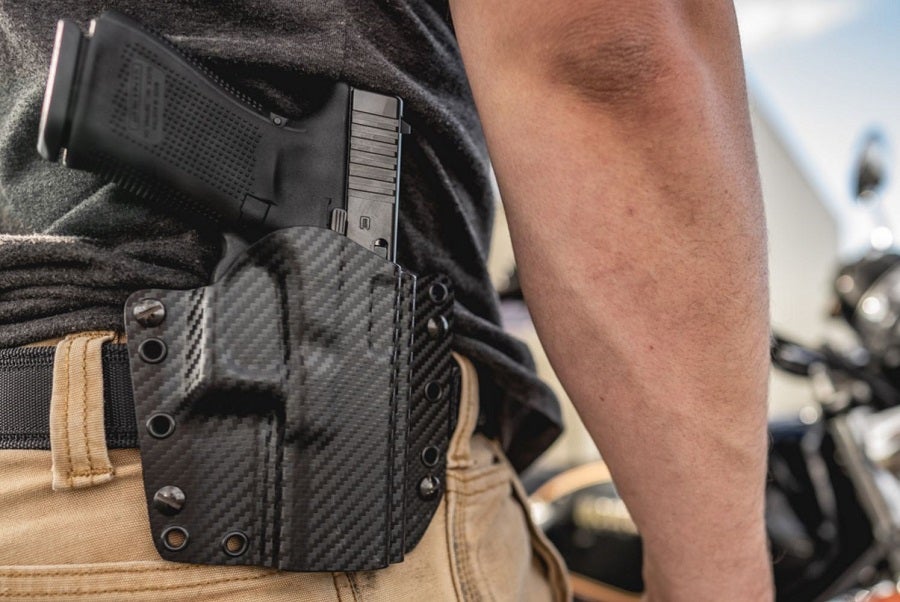Concealed Carry & Open Carry – The Beginner’s Guide to Gun Holsters
Travis Olander 07.28.23

Carrying concealed – and even open carry – is becoming more popular. Maybe you’ve always owned firearms, but you’ve never carried. Maybe you’re ready to start, but first, you need to figure out what gear and holster setup is best for you. IWB (Inside-the-Waistband)? OWB (Outside-the-Waistband)? Leather? Kydex? Appendix carry? The options can feel overwhelming. So, let’s break down gun holsters so you can decide what is the best option for you.
Gun Holsters – First, Get a Gun Belt
Pictured: We The People Tactical Gun Belt w/ Talon Buckle
Handguns are heavy. Even a subcompact, single-stack pistol will have your pants saggin’ after a few hours in the holster – unless you buy a decent gun belt. A gun belt is made to be rigid and inflexible. It prevents sagging and distributes the weight of your gun and holster across your waist, providing comfort for carrying all day. Most gun belts measure 1.5″ in width, which should fit most pants. Cordura and leather are the two common flavors, with traditional buckles and high-speed fasteners alike.
Gun Holsters – Types of Holsters
Picking the right kind of holster is arguably as important as deciding which handgun you’ll carried concealed: A good holster provides reliable concealment, comfortable carry, and a quick and consistent draw without delay. A bad holster can break concealment and draw attention, waste precious seconds should you ever need to draw, or even facilitate a negligent discharge.
Gun Holsters – IWB
IWB (“inside-the-waistband”) holsters seat between your body and pants. The clip on an IWB holster is the only component exposed outside the waistline. Most often, these holsters are situated at the 3 or 9 o’ clock position, depending on your handedness. IWB holsters are, by far, the most common choice in concealed carry.
Gun Holsters – IWB Pros
IWB holsters provide high concealment and quick access to your handgun. Because of their placement along the waistline, they afford a quick, conventional draw. Because IWB holsters are so popular, there are hundreds of options to pick from, and they’re priced competitively.
Gun Holsters – IWB Cons
High popularity and a market saturated with products means there are plenty of cheap, bad IWB holsters. These holsters can cause discomfort if they lack appropriate padding or poorly distribute the holster’s footprint against the body – modifications like a wing or sweat guard can help, here.
Gun Holsters – OWB Holsters
OWB holsters are seated outside the waistband, while the belt clip seats between the body and pants. These holsters also rest at the 3 or 9 o’ clock position.
Gun Holsters – OWB Pros
OWB holsters are more comfortable than IWB holsters. All the bulk and heft of the holster rests outside the pants, rather than being sandwich between your belt and hip. They also tend to provide an even quicker and more comfortable draw.
Gun Holsters – OWB Cons
OWB holsters provide much less concealment than other holsters. And, because the holster isn’t compressed between the tension of your belt and hip, these holsters are more prone to sagging and bouncing around.
Gun Holsters – Materials
Virtually all holsters are made today from one of five materials, or a blend: Leather, Kydex, carbon fiber, neoprene, and synthetic fiber – usually Cordura, or a similar ripstop nylon.
Gun Holsters – Kydex
Kydex is one of the most popular holster materials because it provides an affordable, lightweight, rigid shell with solid lock-up. Kydex holsters are formed by shaping a hard composite under heat and pressure in a mold, which is specific to each firearm’s shape and size.
Kydex holsters are flexible but tough, so relatively little material is required. This composite’s springy characteristic affords a precise fit that can accommodate optics and sights, and any size firearm effectively. Its high strength makes it a great material for daily use and abuse.
Composite isn’t an inherently comfortable material, though. Most Kydex holsters feature a composite bucket with a leather or padded nylon backing. Kydex holsters tend to have well-defined shapes and hard edges, which can increase the risk of printing.
Gun Holsters – Leather
The oldest material in the game is still one of the best: Leather holsters provide plenty of advantages, and few drawbacks. They’re often more expensive than Kydex, but typically found well under the $100 price point. Leather holsters balance comfort and strength. A well-constructed leather holster provides a solid bucket with an acceptably tight fit. Over time, leather holsters mold themselves to the user, increasing long-wear comfort. Leather holsters aren’t as rigid or shaped as other materials, which reduces printing.
Even new, leather holsters are soft enough to be worn all day in an IWB configuration. Leather isn’t breathable, though – when worn against the skin on hot days, sweat can become a concern if there is no nylon or neoprene backing. Like Kydex, leather is strong enough to provide a reliable setup with relatively little material. This reduces bulk and improves concealment.
Gun Holsters – Cordura/Nylon
Pictured: Versacarry Ranger IWB
Nylon holsters are typically the simplest. They’re also usually blended with other materials – often leather, for support, or neoprene, for moisture wicking. Though light on features and short on cost, these holsters are still effective and comfortable. They simply don’t afford the same, solid lock up in the bucket, nor the same advanced belt, buckle, clip, or other retention systems found on other holsters.
These fabric holsters instead focus on comfort and minimalism. They’re often much smaller than Kydex, leather, or carbon fiber holsters, and they’re great for reducing printing when light or hot-weather clothing is worn.
Gun Holsters – Carbon Fiber
Pictured: Galco Corvus OWB Carbon
Carbon fiber holsters are similar to Kydex. They are a touch lighter, and a bit thinner. But these differences are not significant. Kydex is already an optimal material for making a light, strong holster. Carbon fiber holsters are most often sought after for the material’s reputation and aesthetic – if you’re willing to pay the higher price.
Picking the Right Gun Holster – Features to Consider
Buying and old Kydex or leather holster isn’t going to cut it. You need to consider the firearm you’re carrying, the clothing you’re often wearing, and your own body’s size and shape before buying a holster. Certain features will help accommodate all the factors we just mentioned – ensuring your holster is comfortable and easy to draw from, while providing good concealment and retention.
Belt Clips
Good holster clips disperse the load across the belt and help to reduce printing and pinching. Two is better than one, here. Clips with rounded or beveled edges are even better. Always make sure the clips on your holster are sized for the belt you’ll wear – if they’re too short, your holster won’t hold. If they’re too long, your holster can shift and wobble.
Mod Wing
A mod wing, or “concealment wing,” provides an extra attachment point between the holster and your belt. This serves to further reduce printing, but it also can also make your holster more comfortable to wear by further dispersing the load.
Sweat Guard
A sweat guard is a raised portion of the holster, located near the rear sight and grip, that separates your handgun from your bare skin. As the name implies, this guard helps reduce sweat and chafing.
Retention Systems
Active retention holsters feature a locking mechanism that ensures your handgun remains seated inside the bucket, even when inverted. These locking retainers are actuated by a small lever or button on the holster, which is usually placed in tension by a spring. Some holsters – usually Kydex and carbon fiber – might have passive retention: A simple, tight fit enhanced by the rigid composite’s molding and natural flex. Though no button nor lever needs to be pressed, ample force must be used to pull the firearm from the holster.
Adjustable Cant Angle
Holsters with adjustable cant angles – the angle at which your firearm rests inside the bucket – can improve comfort and concealment, while also providing a more natural grip angle for drawing effectively. Now that you’re learned up on all things about gun holsters, check out our review of Safariland’s new Concealed OWB Solis ALS Holster.
